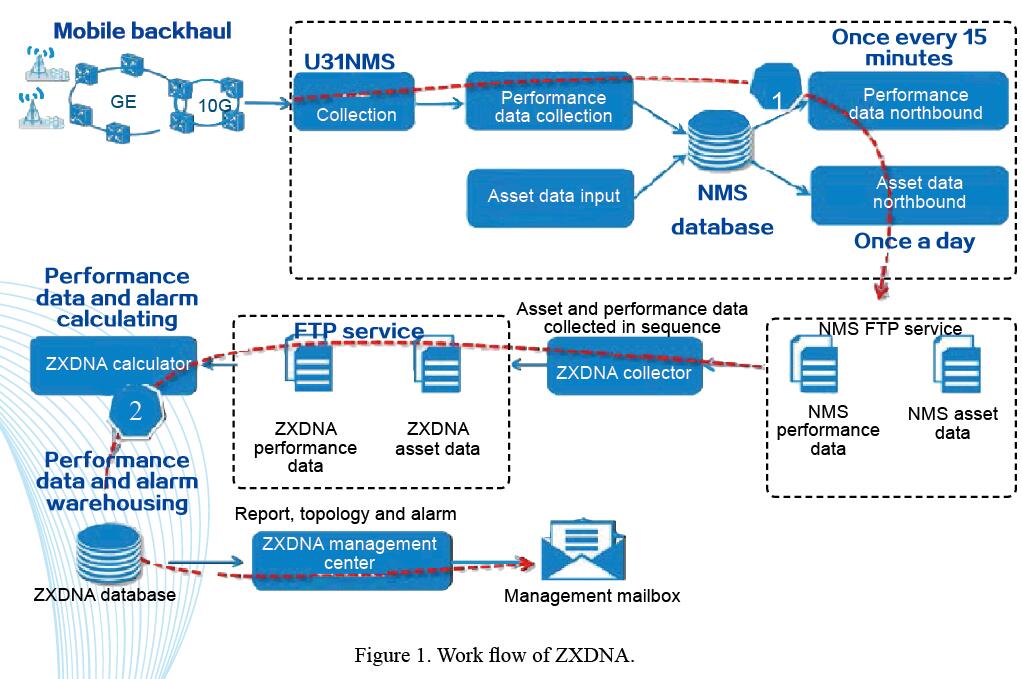ZXDNA: Building Smart Pipes for Optimal Traffic Operations
In today’s burgeoning mobile internet market, internet giants have launched hundreds of thousands of mobile apps, allowing them to get substantial returns from terminal sales, app downloads, traffic-based profit-sharing, and advertising. However, mobile operators have to spend much more on network deployment and capacity expansion to provide a higher network bandwidth for these video, audio, and gaming apps, leaving themselves an increasingly unsatisfactory return on investment. Operators are now in a dilemma of increased traffic but low ARPU and are gradually becoming pipe providers.
ZTE has rolled out ZXDNA, a deep network analysis system to help operators guarantee optimal traffic operations. The following work flow (Fig. 1) illustrates how ZXDNA works.
The hexagonal block 1 in Fig.1 shows the procedure for big data collection. Traffic data is collected and pre-processed in U31NMS and then classified and allocated to the relevant database. The hexagonal block 2 shows the procedure of big data processing and analysis, which is based on ZTE’s big data platform DAP2.0. Traffic data is analyzed and predicted, and the result is displayed to operators.

ZXDNA features powerful data statistics and analysis, abundant graph and table views, and flexible deployment. It can be used for typical traffic operations.
● Big data processing. ZXDNA uses big-data technologies for intelligent data analysis and traffic prediction. Data can be aggregated by the hour, day, month, and year for efficient statistics and analysis, and all aggregated data can be stored for a long time and is quickly retrievable.
● Visible traffic flow. ZXDNA provides multiple graph and table views, such as trend charts, pie charts, star charts, topological graphs, dashboard figures, overviews, TopN views, and event presence. All these views can be customized or combined as required.
● Flexible deployment and hierarchical data processing. In a one-level deployment, a ZXDNA system is built in each prefectural city for data collection, aggregation, analysis, and presentation. In a two-level deployment, a ZXDNA system is set in each prefectural city for local traffic monitoring, and another ZXDNA system is deployed at the provincial level to collect, summarize, and analyze data from each city. This system outputs a network view and report for the whole province. ZXDNA systems in different provinces are managed independently.
ZXDNA enables traffic-based closed-loop operations by deeply analyzing operational data and network. The smart pipe, a critical execution point for traffic operations, enforces bandwidth guarantee, access control, traffic offload, and control policies. The operational support platform is a core control point for traffic operations. It can provide traffic operational policies to ensure enhanced user experience and profitable traffic value.
The current traffic operational policies for mobile operators is to keep up the strength of smart pipes and transit gradually from forward traffic operations to backward traffic operations. ZXDNA helps operators put these policies into service by optimizing smart pipes and facilitating cooperation with OTT service providers.
ZXDNA optimizes smart pipes based on big data aggregation, over-segmented market, and microservices policies. This helps operators increase efficiency, lower costs, and increase revenue from traffic. ZXDNA has been purchased and deployed by China Mobile in 26 provinces and cities around China, becoming the benchmark for successful big-data applications. ZXDNA also uses big-data for deep user behavior data mining and analysis, helping operators and vendors push personalized marketing strategies. Operators can make different marketing schemes for different OTT service providers, and gradually move towards backward traffic operations.